Air Braked Container Services
As the continental railways had standardised on air braked stock
British stock intended for use on ferry traffic to the continent had to be
equipped both with vacuum brake and air brakes. The first air braked stock for
purely British use was built in 1964. First to appear was the HOP 32 AB merry
go round hopper wagon (now coded HAA) followed by the small-wheeled bogie
Freightliner flat wagons (now coded FFA and FGA). Both these wagon types were
intended for use in specialised trades where interoperability with existing
stock was not an issue.
Rather later in the development of rail
services new container types came into service, intended for use in wagon load
traffic services, and these new containers were increasingly provided with air
braked vehicles.
More recently, following privatisation, other
companies have begun to operate services transporting the ISO standard
containers in direct competition with Freightliner. This section deals with the
Freightliner services, the remainder are dealt with in the following section.
Freightliners
The 'Liner Train' service proposed
by Dr. Beeching to operate scheduled inter-city services transporting ISO
standard containers was authorised in 1964. The unions objected to the guard
riding in the rear cab of the locomotive and to the idea that private road
haulage firms should have access to the terminals. The arguments delayed the
launch of the system for nearly a year and the first trial trains ran in late
1965 on a service between London and Glasgow. From 1965 until 1967 only British
Railways owned road haulage was used and the specialised trailers and the
tractors to pull them had been bought in for the job.
The name
Freightliners was in use, and printed on the containers, by 1965 and in 1968
Freightliners Ltd. was established as a separate company from British Railways
operating as part of the National Freight Corporation (NFC) which was essentially the less-than-wagon load railway business spun off as a separate entity in 1969. Freightliners Ltd.
owned only the name, they leased the terminals, containers and container wagons
from British Railways who also provided the locomotives for the trains. In 1969
the British Railways owned stock of ISO type containers were transferred to
Freightliners Ltd. At this time there were 140 Freightliner train services a
day serving 30 terminals.
One unusual use for Freightliner stock was a
regular working to France using the train ferries in the 1970's. The wagons
were modified by being fitted with securing lugs for chaining them down on the
ferry. These workings are more fully discussed in the section on Freight
Operations - Ferry Traffic.
In 1978 Freightliners Ltd became a wholly
owned subsidiary of British Rail but they were not merged with rail freight and
continued with their own management. Freightliners operate their own fleet of
lorries for collecting and delivering the containers and by this time they were
one of the largest inland freight haulage companies in the world. The 1978
Transport Act, which transferred Freightliners from the NFC to British
Railways, included a clause specifically prohibiting Freightliners from
resorting to road haulage for trunk deliveries.
Fig___ Freightliner terminal in the later 1970s
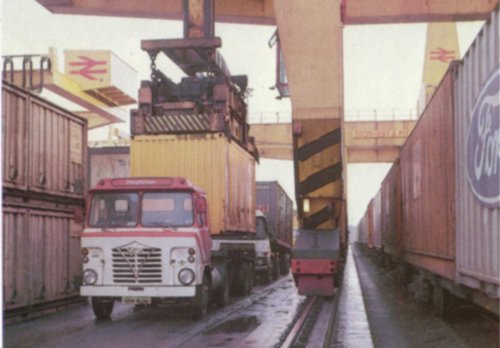
In 1988, following the
general economic recession, Freightliner and British Rail Speedlink services
were officially merged. The two companies were to operate in concert but there
was no move toward combined management or combined trains (the only combined
service I know of was a set of ten Freightliner flats which was regularly
tagged on the tail of a Glasgow-London Speedlink service). In 1991 the
Speedlink service was shut down following heavy losses but Freightliners were
still profitable and continued to operate as before.
In 1994
Freightliners was sold to the existing management team, albeit with some
politically imposed constraints on the resources it could operate and the
services it could offer. The new company kept their existing containers,
lorries and road trailers and became the owners of the terminals, a large fleet
of railway container flat wagons and their own fleet of diesel and electric
railway locomotives as part of the deal.
Freightliner Networks
The original idea behind the Freightliner service was to provide
inter-city trunk hauls to relieve pressure on the roads. To boost the business
Freightliners offered a flat per-container rate regardless of the value of the
contents. This charging regime saw containers being used for such low value
goods as steel sections and standard house bricks.
The vision of the
railway system held by Dr. Beeching's team was born in an era when factories
were concentrated in large towns and cities, the motorway system was still
largely on the drawing board and the biggest road lorries had an all-up weight
of twenty four tons. In that world the Freightliner service represented a real
opportunity to reduce road congestion but in 1964, the year the Liner Train
concept was given the go-ahead, the maximum permitted weight for road lorries
increased to thirty two tons. By 1965 when the first ISO container train ran
the motorways were spreading and making road haulage much more competitive.
Freightliner services to Belfast via Heysham began in 1967 but the
English port soon changed to Holyhead and additional ferry links with Dublin
were established. British Railways Shipping Division (later renamed Sealink)
operated two container carrying ships on the Irish Sea trade. In 1968 the first
rail served import/export Freightliner terminals opened in Southampton and then
Harwich to handle containers from the Continent and farther afield. At this
time the great majority of Freightliners work was internal freight haulage in
the UK and most trains were loaded with Freightliners own boxes.
Soon
after the transfer of Freightliners to the NFC in 1969 the pricing policy was
changed dramatically. The rates generally increased and the focus shifted from
bulk to quality, bringing an end to the carriage of steel and the closure of
the terminal in Sheffield. Interestingly enough bricks were still carried, by
this time they were moved in half-height open containers with removable sides,
but these were the much more valuable 'facing' bricks. Entire train loads of
bricks were moved from the brick fields of the eastern counties and midlands,
enthusiasts called them 'brickliner' or 'Fletliner' trains, the containers were
yellow with London Brick Fletliner on the sides, I have not yet found a
photograph so I cannot attempt a sketch. This traffic remained until 1985 when
the transport was switched to road.
By the 1970's industry was
generally moving out into the countryside away from the rail heads and relying
on the new motorways to meet their transportation needs. By this time however
the ISO container was becoming the dominant mode of transportation for
international trade. Large purpose built ships had entered service and British
ports were handling large numbers of containers from the Far East and America
as well as from Europe. The companies shipping containers from father afield
have to arrange the delivery and collection of those container in the UK and
Freightliners Ltd. offered just the service these firms needed.
In
1986/87 there was a major reorganisation of the Freightliner service with ten
inland terminals being closed down. This rationalisation was primarily a
reflection of the changing emphasis toward import/export traffic and away from
UK internal services but most of the terminals that closed dated from the early
days and suffered from a severe shortage of on-site storage room for containers
awaiting collection. By the 1990's over 90% of Freightliners business was
dealing with maritime container trade.
Fig___ Permanent Freightliner
Terminals
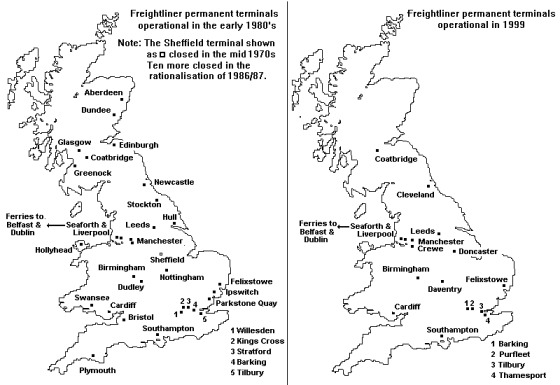
Freightliner Road Vehicles
The original railway
container terminals of 1965 were all operated by railway staff but the road
tractors and trailers used were bought for the work. Tractors from Seddon,
Dodge and AEC were coupled with a large fleet of purpose built skeletal
semi-trailers. From 1967 private road haulage firms were allowed to collect and
deliver from Freightliner terminals but the company maintained a large fleet of
lorries and trailers in their own livery.
By the early 1980's
Freightliners owned a fleet of nearly five hundred tractor units with over a
thousand road trailers. In spite of the changes during the 1980's and the
growing shift towards international traffic Freightliners remain one of the
larger road haulage firms in the UK. At the end of the 1990's they were still
operating a fleet of 238 articulated tractors and 530 road trailers. The
Freightliner owned road trailers are themselves sophisticated pieces of
equipment, some are equipped for tipping (used for discharging bulk cargo
without lifting the container off the wagon). The trailers have wheels which
can be moved along their length to allow a single standard trailer to safely
carry containers of various sizes.
Freightliner Locomotives
Prior to 1994
Freightliners had to hire their locomotives from British Railways and there
were many complaints about these engines failing to appear on schedule. Steam
finally disappeared from British railways in 1969, replaced by diesel and
increasingly by electric locomotives. There are rumours that photographs exist
of a Freightliner train being hauled by a British Railways standard steam
locomotive but to date I have not manager to trace any of these
pictures.
Freightliner trains can get heavy, upwards of a thousand tons,
and on some routes this required double-heading. The most common diesel engine
type used was the Class 47 but when double heading was required Freightliners
preferred to hire pairs of Class 37 locomotives.
As part of the 1994
management buy-out deal Freightliners got their own locomotives, forty electric
Class 86 and forty nine diesel Class 47. The mixed traffic Class 47's had
proved expensive to maintain and in 1997 Freightliners were talking with
General Motors regarding the purchase of a fleet of the Class 66 locomotives
already ordered by EWS. Maintenance costs for the existing General Motors Class
59 locomotives are about twenty percent of those for the Class 47 and the
reliability of the GM locomotives means that fewer locomotives would
theoretically be required. In the meantime however Freightliners have
re-engined a number of the elderly Class 47s (six as of 1999), fitting them
with new power plant supplied by General Motors. The modified locomotives are
more powerful that the original build and are re-classified as Class 57.
Freightliner Railway Wagons
Purpose designed bogie
flat wagons were built by British Railways for Freightliner traffic, originally
coded Conflat E they became FFA and FGA under TOPS. These remained the property
of British Railways and were only leased to Freightliners until the management
buy out of 1994.
To allow them to carry eight foot high ISO containers
the original Freightliner bogie flat wagons have wheels that are two foot eight
inches in diameter instead of the more usual three foot one inch. This reduces
the height of the body to only 37 inches (940mm) above the rail top.
Freightliner wagons being less than normal height cannot have conventional
buffers and couplings. Most are plain flat wagons with bolt-together combined
buffer/couplings which are formed into the middle of the rake and are called
'inner' vehicles. A small number have the bolt-together buffer/coupling at one
end with a raised buffer beam and conventional coupling at the other. These are
called 'outer' vehicles and one is attached at each end of the rake to allow
the locomotive to couple up. The outer vehicles have brake pipes fitted at the
buffered ends but all other brake couplings are built into the rigid bar
buffer-couplings between the wagons.
In 1964 two different types of
bogie wagons were built, the first design was forty two feet six inches feet
long with buckeye couplings, the second was sixty two feet six inches over
headstocks and had bolted plate type couplings. The latter became the standard
and only four examples of the former were built (two inner and two outer
vehicles). Air operated disc brakes were fitted as standard.
Originally
the bogie wagons were operated in fixed rakes of 5 wagons, but in the 1990's I
have seen as few as two 'end' wagons together and groups of three seem common.
The shortest Freightliner train I have so far seen comprised a single set of
five wagons but in 1997 I saw a train comprised entirely of outer vehicles
coupled in pairs and one train consisting of just two flats (of a more recent
design with conventional buffers and couplings at each end) each carrying a
single container.
The original small wheeled bogie flat wagons could
carry standard eight foot high containers but when eight foot six inch high
containers appeared a new wagon called a 'Lowliner' was produced. This is a
four wheeled flat topped vehicle, forty feet (12191mm) over headstocks and with
a twenty six foot four inch (8001mm) wheelbase. It uses the same wheels as the
bogie flats but as these are fitted directly to the chassis the height above
the rail is reduced to only 34.5 inches (876mm) allowing the eight foot six
inch high containers to be carried. The Lowliners have drop-down ends to allow
them to be used as vehicle carriers but this has not been a common use. Two
sixty foot long bogie lowliners were also built, running on six wheeled bogies.
These are distinctly odd looking vehicles as the bogies seem to be built into
rather than mounted under the chassis. I believe the four wheeler types are
TOPS coded FLA and the bogie lowliners are coded FHA.
By the 1980's
problems had appeared with the original Freightliner vehicles. The increasing
use of forty foot containers coupled with increasing container loadings meant
that the long bogie wagon chassis were placed under uneven stress, shortening
their expected working life. Freightliners began assessing the replacements for
the original flat wagons in the early 1980's and there was some talk of shorter
four-wheeled designs being favoured at the time.
In 1990 Freightliner
invested in some French built 'Multifret' wagons which can carry containers or
road-rail 'swap-bodies', the swap body is basically a road rail container
configured like the trailer of a conventional articulated lorry but without the
wheels. The plan was to offer 90 mph services but in the event British Railways
restricted these vehicles to 75 mph. The Multifret swap-body is eight feet two
inches wide, which is very wide by British railway standards and restricts the
routes on which they can be carried.
In the early 1990's Freightliners
bought about seven hundred new sixty foot long container bogie flat wagons TOPS
coded FSA from a French manufacturer (I assume these were a different lot to
the 'Multifret' type). These wagons have a raised buffer beam at one end and a
lowered but otherwise conventional buffer beam at the other and operate in
pairs. At this time they began mothballing the original 1960's FGA and FFA
wagons. As traffic picked up in the later 1990's the older wagons were returned
to service and more container flat wagons were hired in from Tiphook (the
railway vehicle leasing company). By the end of the 1990's there were about
seven hundred of the original FGA and FFA, seven hundred of the French built
FSA bogie flats, over a hundred wagons leased from Tiphook (including 'pocket
wagon' types able to transport nine foot six inch high containers) and about
forty or fifty four wheeled Lowliners.
By the later 1990's almost one in
five of the 'deep sea' containers were the tall nine foot six inch high type,
which need to be carried on purpose built drop-centred wagons. Freightliners
hired seventy five Finnish built wagons of this type from Tiphook. in the late
1980's (see Fig___).
Freightliner was one of the first to offer a
British Piggyback service when in 1998 they began operating a daily service
carrying specially built road semi-trailers of chemicals between Manchester
Trafford Park and Tilbury. The tank semi-trailers were designed and built for
this work, they resemble standard articulated lorry tank trailers but have two
lifting points on each side for standard ISO container lifting gear. The wagons
used were low-loading 'pocket' types which had formerly been used for pet food
in Speedlink days. The wagons were originally operated by Charter rail but are
now owned by Tiphook/GE Rail Services.
Freightliner Wagon Types Updated Information
The
following was found on the Freightliner website. The list does not include the
piggy-back wagons (at least I do not think it does) but they are not
Freightliner owned stock.
FGA (outer) & FFA (inner) - Original Freightliner
wagons operating in fixed train sets first introduced during the 1960's.
Containers up to 8' 6'' high can be loaded onto these wagons.
FSA
(outer) & FTA (inner) - Standard Freightliner wagons operating in fixed
train sets introduced during 1991. Containers up to 8' 6" high can be
loaded onto these wagons.
FLA - A low platform wagon introduced in 1991
and capable of carrying containers up to 9' 6'' high, operating in fixed
sets. There are two types both with the same code, the inner wagons can handle
containers up to 45 feet long, the outer wagons can handle boxes up to 40 feet
long.
KFA - Introduced in 1998 these 60' wagons operate singly but can
only carry 8' 6'' high boxes
KQA - The 'Pocket wagon' introduced
in 1998 and capable of carrying containers up to 9' 6'' high, these
operate as single wagons.
IKA - A low platform wagon introduced in 1999
capable of carrying containers up to 9' 6'' high on certain cleared
routes, operating in fixed two wagon sets.
HHA - The HHA wagons are 4 axle
Coal Hopper Bogie vehicles, with 4 automatic bottom discharge doors. All wagons
are fitted with the new "track friendly" bogies.
Freightliner Containers
The containers carried by
Freightliners were initially British Railways built wooden floored boxes with a
smooth aluminium skin inside and out. These could be stacked two high when
empty but could not be stacked when loaded. The initial designs were based on
containers ten foot, twenty foot and twenty seven feet long but the longer
containers had been changed to the ISO standard thirty foot by the time the
service had finished its trials. The ISO standard was still evolving at the
time and twenty seven feet was considered better size for road haulage than the
later standard thirty feet. During the trials twenty foot long and twenty seven
foot long half-height and flat open types of container were found to be stable
with loads up to six feet high. Various experimental types were built,
including a powder carrying tank, as the containers were not expected to be
stacked this had a simple rectangular floor with no frame around the tank
itself. The container cranes used long arms which engaged with pockets on the
base of the Freightliner containers.
The international standard ISO
containers were designed to be stacked several high on ships and were often
seen stacked in yards. The ISO boxes had oval holes in reinforced corners to
take 'twistlock' securing lugs, these containers can be lifted by a simple
frame which rests on top of the box and engages with the top twistlock pockets.
The original smooth sided British Railways built Freightliner boxes were
steadily replaced with the standard ribbed sided types fitted with top-lift
points on their corners by the end of the 1970's.
By this time there
were a number of privately owned containers arriving at British ports but
Freightliner had been set up to handle the inland movement of freight rather
than imports and exports and comparatively few import/export containers were
seen on the trains. The Freightliner owned containers were restricted to UK
internal use only until the 1980's when they were allowed to travel on European
services.
British Railways rules required a guard to be carried at the
rear of the train. The standard `goods' guards vans were sometimes added to the
rear of Freightliner trains but these were not designed to operate at
Freightliner speeds. Some trains had a passenger brake van either at the rear
or (just as often) attached behind the locomotive but this added weight and
length to the rake. Freightliners tried modifying a 10 foot container to make
it into a `guards van', the first of these had a simple door in each side with
a raised lookout on the top. Later a purpose built unit appeared with a
platform and door at one end and perspex hemisphere bubble look-outs on the
sides. These were found to give a dangerously poor ride at the high speeds of
the Freightliner system so from about 1967 the standard gangwayed passenger
guards brake vans were used. In about 1970 an agreement with the railway unions
was reached and the guard moved to the rear cab of the locomotive.
The
original purpose built guards container was handed over to the National Railway
Museum in 1985, the sketch below is based on a photograph of the handing over
ceremony and on photographs taken when the box was in service. I remember
seeing this container at the Manchester Longsight terminal in service in the
1960's, at the time it appeared terribly futuristic. There appears to have been
an earlier design, based on a simple modification to the standard Freightliner
ten foot box, this had a door in the side and a top mounted look-out. I have
not traced any information on this unit however and the only photograph I have
seen shows it sitting on the first wagon behind the locomotive during the
original trails in the 1960's.
Fig ___ Prototype Freightliner 'Guards
container'
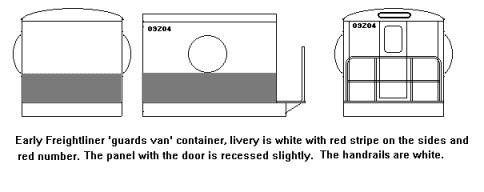
By the 1970's the ISO 10 foot
container was rare and 20 foot boxes were the norm with the new 40 footers
becoming more popular. The 30 footers were never terribly common in
international trades although Freightliners had a number of this size in their
inventory. By this time there were over thirty thousand Freightliner owned
boxes in service, augmented by the many thousands of privately owned ISO
containers operated by companies all over the world and Freightliners Ltd. was
the biggest overland freight haulage company in the world.
The
international trade in containerised goods was growing steadily and
Freightliners Ltd. was soon an important player in the British end of the
market. Much of this trade operates to and from the Far East and America, the
so-called 'deep sea' traffic, and it was impractical for Freightliners to enter
into the world wide container leasing business. As the emphasis of the business
shifted from UK internal trunk hauls to import/export traffic they began
winding down the number of boxes they operated.
By the early 1980's
Freightliners owned just over five and a half thousand assorted box and flat
top containers of 10, 20, 30 and 40 foot design. They also owned a number of 30
and 40 foot curtain sided containers and about this time they began allowing
their containers to move abroad to Ireland and the continent. By the end of the
1980's there were still a number of Freightliner owned containers in service
but over the following decade these were either sold off or scrapped and by
about 1998 the last of these had been withdrawn from
service.
Freightliners remain closely involved with developments in
containerisation and in 1999 they unveiled a new type of container jointly
developed with a company called Car Rac. I believe these are actually standard containers, usually 40 foot in length, with a set of moveable frames inside allowing the cars to be tilted and lifted into the upper part of the space inside. The prototype demonstrated in 1996 was able to carry six small
cars and was intended for small deliveries to dealers and the like rather
than bulk movement. I am not sure what happened to that service but a company called Car Rak was operating in 2014 using what appears to be the same system and providing international shipping of mot5or cars and caravans in standard containers.
In about 2002 a new
container size appeared, at 45 feet long this offers some theoretical
advantages to the shipper (and they are already in service) however on British
roads these containers tend to make life difficult for the delivery
drivers.
In the 1970's Freightliners introduced a computer system for
keeping track of the containers in their care. Called COPS it is broadly
similar in principle to the TOPS system used by British Railways. The
Freightliner locomotives and wagons are of course covered by TOPS but
Freightliners customers are more interested in the whereabouts of their
containers and COPS has the facility for direct access by subscribers.
Freightliner Livery
The original Freightliner
container livery was light grey with a red band bearing the word Freightliner
and the British Rail double arrow logo in white. The double arrow logo was
always toward the door-end with the word Freightliner toward the non-door end
on both sides of the box. This made it easy for staff to see which end had the
doors which was important when they were being placed on road lorries for a
local delivery. The red band was continued across the ends of the containers.
The only lettering on the ends of the containers was the number in the upper
right corner.
The standard livery for Freightliner owned containers in
the late 1980's was officially 'grey with a smaller self adhesive panel towards
the upper left corner bearing the Freightliner logo in white on a red
background' but I have not been able to trace any photographs of this livery.
The liveries shown below are all taken from photographs from the early
1980's.
In late 1998 Freightliner adopted a new livery of dark green
with the Freightliner name in yellow, the triangular logo remains as the 'dot'
above the 'i' in Freightliner. This livery was applied to the prototype Car Rac
container shown above as well as the Freightliner locomotive fleet. The ends of
the locomotives remain yellow.
Fig___ Freightliner Container
Liveries

From the available illustrations the road
tractor units seem to have been painted in a white livery with the British
Railways 'door to door' logo on the door. The associated trailers had what
appear to be white sides with black lettering. In 1966 the road vehicles owned
by British Railways were transferred to National Freight Carriers and were
progressively re-liveried for that company but in 1967 Freightliners began
operating their own fleet of articulated tractor/trailer units. Also in 1967 an
agreement was reached with the unions to allow road haulage contractors to
bring their lorries into the Freightliner terminals. The 'open terminal' proved
to be one of the cornerstones of the success of Freightliners.
The
Freightliners Ltd triangular red logo was introduced in 1969 and was combined
with a light grey body and the word Freightliners in black. This logo was used
on both containers and on the Freightliner fleet of road vehicles. In 1980 the
road lorries had a white and red colour scheme as shown below but by the mid
1980's this had changed with the triangular shape inverted. The triangular logo
can slope either way and on the lorries the higher end was at the rear of the
cab on both sides.
The 1999 Freightliner lorries are in a their new
colours to match the locomotives with a yellow front and partial yellow sides
and the rest in green. The new yellow on green logo is displayed on the front
of the lorry and also on the yellow part of the sides.
Fig___
Freightliner owned lorry liveries
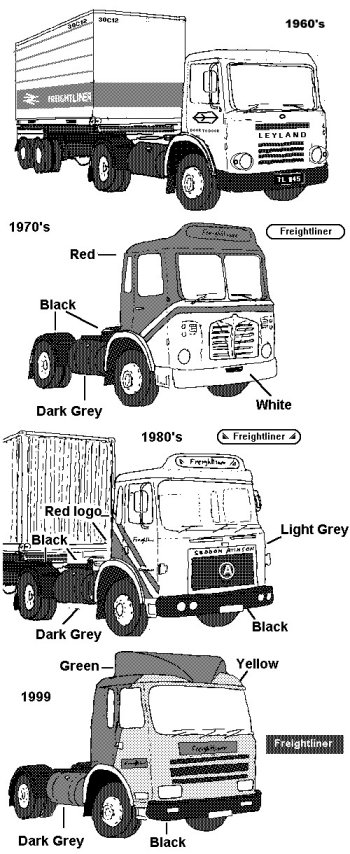
When I visited the Manchester Freightliner terminal in 2007 the tractor units were all over yellow with Freightliner in green and the trailers were green with the word Frightliner in yellow on the side. A photograph of one of these modern units will be found below. Freightliners have always had a reputation for quality and certainly all the vehicles and equipment on view in 2007 were very clean and presentable and the staff all smartly turned out in their green uniforms.
Freightliner Terminals
The size of the ISO
container is close to the limit for the British loading gauge so Freightliner
services operate only on restricted routes serving specially equipped terminals
at the ports and major cities. The first Welsh Freightliner terminal, at
Cardiff opened in 1967 and is a typical example of the large but essentially
simple yards. This terminal had three parallel tracks over a thousand feet in
length separated by roadways and spanned by several container cranes. Some
terminals, for example Aberdeen and Longsight (Manchester), had a set of two or
three tracks at normal spacing with a roadway running along one side. The
container cranes used are capable of lifting boxes from the outer track over
loaded wagons on the roadside track to place them on road trailers on the
roadway. The cranes used were originally Drott Travelifts, running on small
pneumatic tyres. Gantry cranes running on pneumatic tyres are
usually referred to as RTG's or Rubber Tyred Gantries. These were supplemented by heavy rail-mounted 'Goliath' gantry
cranes in the larger terminals. The early Freightliner containers were designed
to be lifted using lifting points on the base, the cranes used had long arms
which could fold upwards as the moved over the container then lower down to
hook onto the box. As the ISO standard became established and stackable
containers became the norm these cranes had new top-fastening lifting frames
fitted.
To move the containers about within the terminal the hydraulic
'straddle carrier' was commonly used but these were subsequently replaced by
large fork-lift type vehicles (see under Materials Handling - Containers for
more information on straddle carriers and fork lift trucks).
By the
early 1980's there were thirty seven purpose built ISO container terminals in
use two thirds of which were operated by Freightliners. The remainder are
operated by third parties such as 'Containerbase' who have arrangements with
customs and excise for local clearance of containers for 'TIR' services (see
under International Road Haulage).
The original terminals built for
Freightliner traffic were often quite small, which is handy from a railway
modelling point of view but in the event proved something of a problem for the
company. The operational nature of ISO container traffic has been different
from earlier experience, the containers themselves are plentiful and cheap, so
they often end up stacked up in yards for days at a time awaiting collection
and delivery. This told against the small original yards, built on the
experience of earlier systems where the railway owned containers were
themselves relatively valuable and were generally subject to a rapid turn round
to keep demurrage costs to a minimum.
The terminal at Longsight south of
Manchester had two sidings, each capable of holding about fifteen Freightliner
flat wagons fed from a head-shunt. The containers are usually handled by a
mobile gantry crane fitted with a lifting frame which engages in the
twist-locks on the top corners of the container. The Longsight terminal had the
two loading tracks inset into concrete with one lorry road up the centre and
another to one side, the crane bridged both tracks and both roads.
Fig ___ Freightliner Terminal

The problem with modelling a full container depot is simply one of size. The standard Freightliner flats operated in fixed rakes of five wagons, you should have ten for a convincing train load, and that adds up to about five feet or just over 1.5m of siding space. Added to this is the head shunt (I have not yet seen a track plan consisting of through-loops, although there may have been some) which even in the lower example shown above (assuming the rakes are broken into five wagon cust for shunting) needs to be long enough for five wagons and a loco, say three feet or 1m. Allowing for point work you will need, in British N, about 10 to 13 feet of length for the terminal, although the depth can be kept down to about a foot (30cm).
By the 1970's the lack of
storage space in the original small yards was becoming a problem, resulting in
the closure of many of these yards in the mid 1980's.
Freightliners Ltd.
has increasingly concentrated on the import/export container business and they
have regularly laid on additional services to ports where container shipments
are arriving even when these do not have an associated Freightliner terminal.
Inland they have also operated services to ad-hoc terminals where freight flows
justify the cost of setting up a temporary crane. The Ministry of Defence made
use of these temporary services, some of which remained in use for several
years.
In the early 1980's there was some interest in self powered crane
wagons that can convert any two track yard into an instant, low cost, container
depot. A West German firm had built such a unit which was also capable of
transporting a single forty foot container and this was brought to Britain for
trials. A British firm subsequently built a prototype of a similar machine (not
able to carry containers).
The self powered container crane wagon was not
adopted, although the vehicle was later used as the basis for a number of track maintainence units, and the smaller yards are usually equipped with conventional container
gantry cranes (usually the rubber tyred gantry or RTG type).
Modelling one of these smaller terminals is a more practical proposition, allowing short rakes of perhaps five wagons to run into a single siding with a single RTG crane standing on concrete pads in a fixed position. There are no 'standard' track plans for such a terminal, anywhere with space for the crane and road lorry access could be used, and these do not have the large stacks of containers on-site.
The sketch below shows such a small crane, similar in size although different in design to the original
Freightliner crane at the Manchester Ardwick yard (see photos below), and shows the grapple arms
in the lowered position (these are used these days for 'flat' containers and
for road-rail semi-trailers and swap bodies).
Fig___ Small
Freightliner type Container Crane
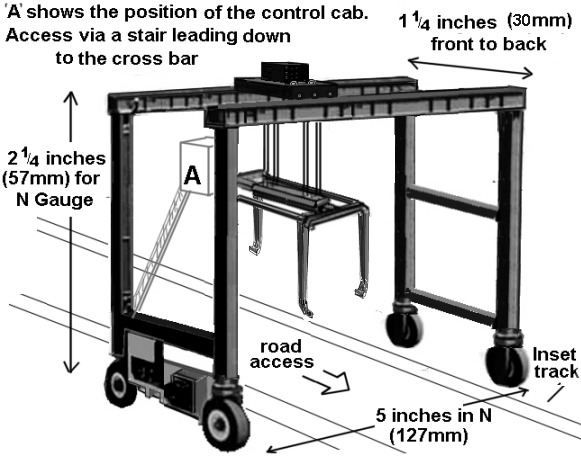
Vollmer offer the only really convincing RTG type container handling crane in N (kit number 7905) which is suitable for use on layouts from the 1960s to date.
Phillip Holmes was able to advise that the small container terminal within the Trafford Park Industrial Estate and operated by Containerbase (a firm specialising in TIR international containers) was still using older gantry cranes. Two of the cranes are of a fairly old rubber wheeled design, similar to those formerly used in the former Freightliner terminal at Longsight. On a rather dark early spring morning in 2007 I was able to obtain several photographs of these cranes, Ian Mackay was able to rescue these to produce useable pictures.
The containers are stacked around the yard, handled by rather large straddle carriers. I would estimate these can lift the boxes onto stacks about four containers high. There are presumably other container handling cranes in the yard as several of the stacks have no 'path' for the straddle carrier legs between the stacks, indicating they were placed using either a big 'fork lift' type crane or by a more modern 'reach stacker'. Non of these were evident on the day the photographs were taken, but the straddle carriers were busy.
Fig___ Large straddle carrier

There are a total of three hydraulic gantry cranes in the yard, I believe the hydraulic gantry crane shown here is similar to the early Freightliner depot crane at Longsight, south of Manchester, note this crane is running on rubber tyred wheels not rails. There are two of this type (a normal compliment for a Freightliner depot) with a third crane of rather more modern appearance.
Fig___ General View of the Container Crane
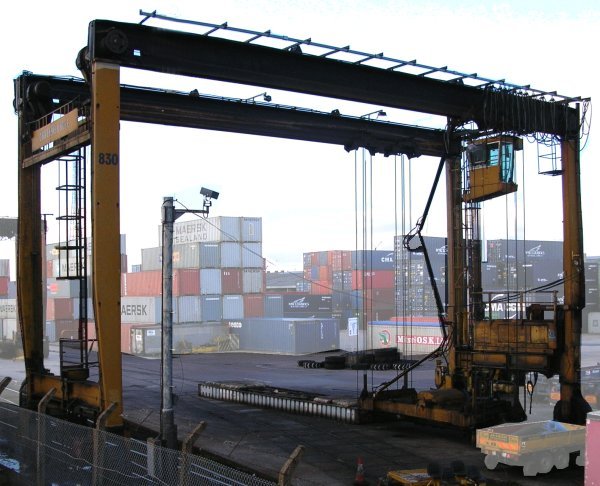
Points to note are the double-hinges arm carrying the hydraulic hoses from the top of the gantry to the lifting frame, this folds into a Z shape as the frame is lifted. The electrical cables are suspended from a series of sliding hooks suspended from side rails. There are a total of four lifting cables in each corner of the lifting frame.
Fig___ Close up of lifting frame

Fig___ End view showing motors and cab
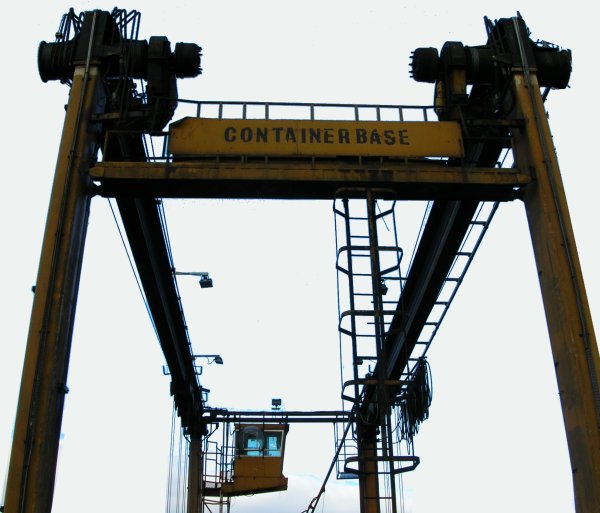
Fig___ End view detail of cab, note clear 'hood' on cab window

The cranes used for the ad-hoc terminals are
often older types and generally quite small. Some appear to have been recovered
from the smaller Freightliner depots closed in the 1980's. There was such a
crane operating for the RAF in Scotland in the 1980's which bore a striking
resemblance to the crane at the former Manchester Longsight yard. These ad-hoc
terminals are usually only provided where Ministry of Defence traffic is
handled but I believe a couple of the redundant cranes were been re-sited to
yards handling containers which although not ISO standard designs use the same
lifting arrangements.
Mmajor terminal in 2007
A subsequent expedition to Manchester located the current Freightliner terminal and the new European container terminal associated with the channel tunnel link and currently run by EWS following their acquisition of Railfreight Distribution when BR was privatised.
Points to note are the six tracks passing under the gantry, the yard is evidently double ended as the two tracks on the right are coming the other way and end at buffer stops. The yard has at least two Class 08 shunters operating, one of which can be seen in the left of the picture. The crane is running on rails, the buffer stop for the crane can be seen on the right. Note the size of the new cranes, spanning six tracks with extensions extending over a roadway two track widths to one side, three track widths to the other. This enables containers to be transferred direct to or from road to rail however a lot of containers are stacked up to four high in the yard. The lifting gear in the gantry cranes is housed in a large enclosed cabin suspended between the two side rails. The cab is suspended quite low below the lifting gear, in the red painted gantry to the right of the main legs.
Fig___ Freightliner terminal in 2007
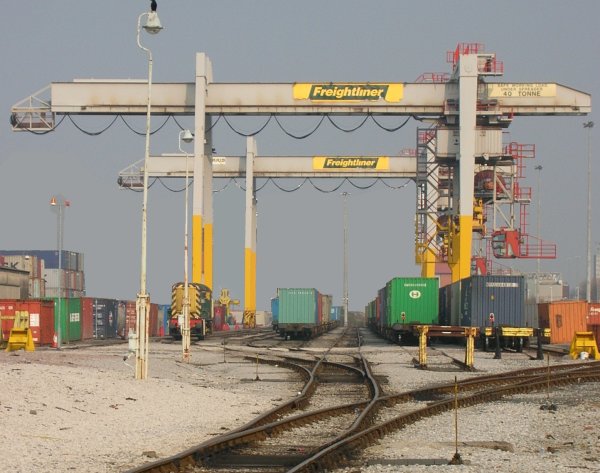
Fig___ Freightliner terminal in 2007, angle view of cranes
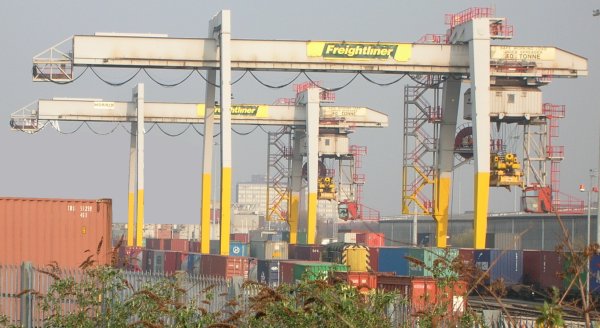
Fig___ Modern Freightliner terminal, close up of lifting gear on cranes
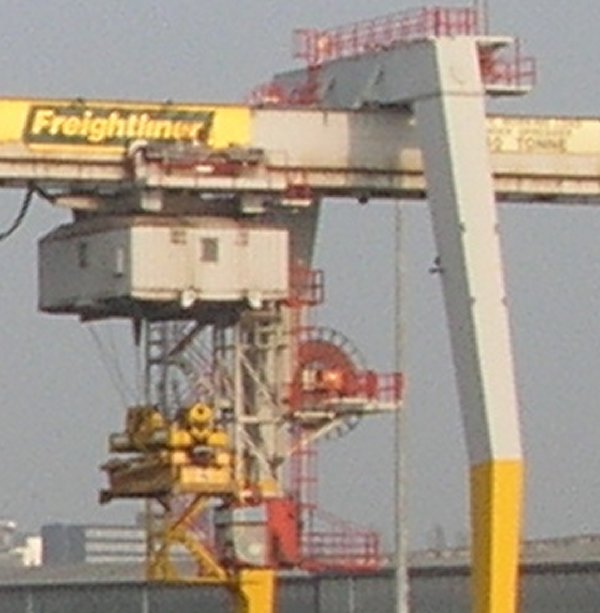
The containers are (in this new yard) handled by 'reach stackers', big beasts able to stack the boxes about six high. This must be one of the few jobs where the company car is a Ferrari.
Fig___ Freightliner terminal in 2007, reach stacker
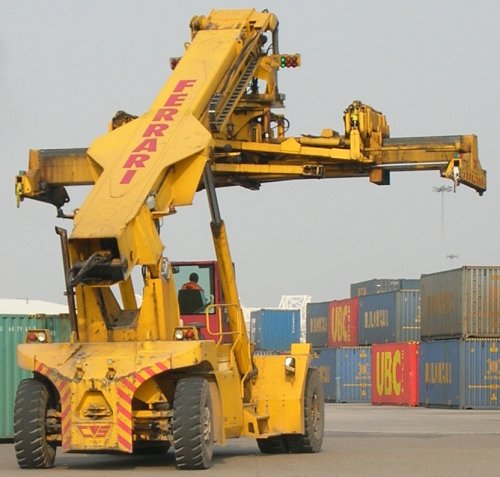
In 2007 the Freightliner lorries were all yellow tractor units with a green trailer.
Fig___ Freightliner lorry in 2007, showing all yellow livery

The trailers used are all fixed length, not the older adjustable length types, but they can carry containers of various lengths, the example shown has a single 20 foot box, note how it is loaded centrally on the trailer.
Fig___ Freightliner lorry in 2007 carrying single 20 foot container
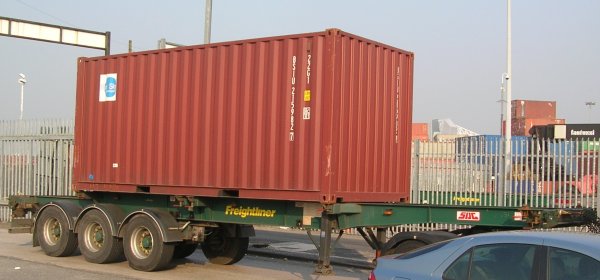
The EWS container depot is another massive enterprise, built to handle overseas traffic arriving via the Channel Tunnel. This terminal has two massive cranes of somewhat different appearance to the Freightliner type. These cranes have two heavy side rails with the lifting gear running between them and although they extend about two track widths on one side they do not extend beyond the tracks on the other side.
Fig___ EWS international container terminal crane in 2007
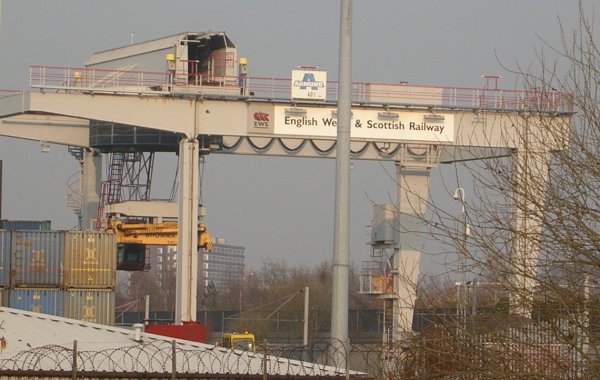
The signs shown below are on the approach tracks to the container terminal, the on on the right is a stop sign before a road crossing (ungated as this is on an industrial estate), the sign on the right is at the rail entrance to the terminal.
Fig___ Container terminal track side signs in 2007
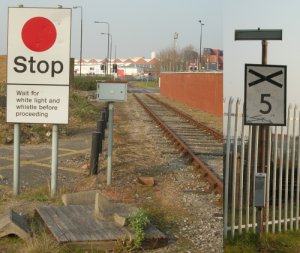
One problem for the modeller is the number of
containers required for stacking your yard. Container flats wagons with less
than a full load are often seen, it is quite usual to have anything up to a
third of the wagons in a rake travelling empty, so you can re-deploy the
commercial containers as 'clutter'. This still leaves you rather short for any
but the smallest of depots however, so you need to consider the alternatives.
Unpainted containers are available commercially, and these make up into very
pleasing models but for a modern yard with lots of stacked boxes making your
own is a lot cheaper. Standard one inch by one inch PAR (planed all round)
timber is 22mm by 22mm in size. For a standard eight foot container we need
something 16.5 x 16.5mm and if you have the facilities (a bench with a vice and
a wood plane) you can plane down a strip of the above timber. Having produced
the strip you can now cut this to length as required (giving you the option of
making thirty or forty foot long containers, or even twenty seven foot early
Freightliner containers, not currently available commercially).
The
livery can be added using paper wrappers, the best option here is to prepare
the wrapper using pre-coloured paper printed using a computer printer.
Personally I would prepare a sheet with a number of these wrappers, printed
twice the required size and take them to the photocopying shop where they can
be reduced on the high resolution colour copier. Several copies can thus be
produced enabling you to generate a large number of containers for stacking in
your yard.
^
Go to top of page
International Good Guys ~ Making the world a
better place since 1971 ~ Site maintained by

All material Copyright © Mike
Smith 2003 unless otherwise credited



















